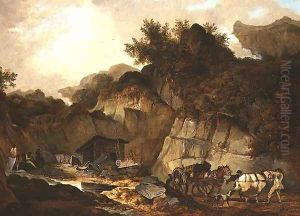(circle of) Stubbs, George Paintings
George Stubbs, born in 1724 in Liverpool, England, is an artist whose name is synonymous with the detailed and realistic portrayal of animals, particularly horses. Stubbs was not just a painter but also a self-taught anatomist, which set the groundwork for his unparalleled representations of the animal form. His dedication to understanding the anatomy of horses was such that he spent 18 months dissecting equine carcasses to produce his groundbreaking work, 'The Anatomy of the Horse', published in 1766. This endeavor not only demonstrated his commitment to his art but also his scientific approach to painting, which was quite ahead of his time.
Stubbs' work extends beyond equine anatomy and rural British scenes; he also explored exotic animals, historical subjects, and portraits. However, it is his equestrian paintings that have cemented his legacy in the art world, with works such as 'Whistlejacket' and 'Mares and Foals in a River Landscape' being particularly celebrated for their lifelike quality and emotional depth. Stubbs worked during a period of great interest in natural history and science, which is reflected in the meticulous detail of his paintings.
Despite his significant contributions to British art, Stubbs was somewhat of an outsider in the official art establishment of his time. He was never a member of the Royal Academy of Arts, although his work was exhibited there. His approach to art, focusing on nature and the scientific rather than classical and historical themes preferred by the Academy, perhaps explains this exclusion. Nonetheless, Stubbs' influence was substantial, and his works are now prized for their unique blend of scientific accuracy and artistic beauty.
George Stubbs passed away in 1806, leaving behind a legacy that continues to influence the world of animal and sporting painting. His work is celebrated for its pioneering spirit and has earned him a place among the pantheon of great British artists. The term 'circle of Stubbs' refers to artworks created by contemporaries and followers who were influenced by Stubbs' style and subjects, further testament to his lasting impact on the art world.
